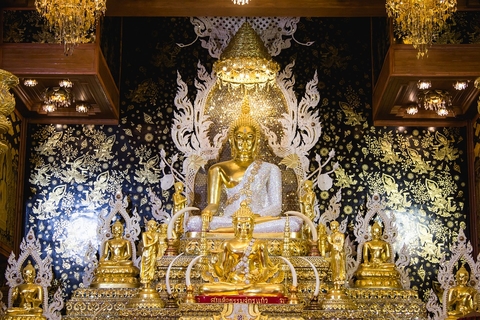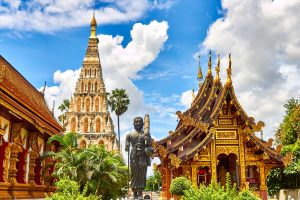A Little Knowledge of Thai History Is a Good Thing
If you have any desire at all to understand Thai culture, it’s a good idea to know a little something about its history. After all, Thailand is an ancient country, and has been shaped by thousands of years of tradition – unlike the more modern Western country where you were raised. So bear with me while I give you the briefest of overviews of our long and rich history.
Historians and linguists disagree about just where the original Thai people came from, but there’s evidence that people have been living in what is now Thailand for at least 100,000 years, and may have been the first agriculturists and metal workers in human history.
Linguistic evidence shows that early Thai people were nomadic, and settled in river valleys throughout South Asia – from the Assam region in India all the way to the Red River in Southern China, covering Laos, Cambodia, and what is now Viet Nam.
These nomadic Thai peoples were ruled by “chieftains,” and as they travelled throughout Southeast Asia, whenever they encountered a group of people already living there, the Thais were able to displace them with little to no violence. Some historians think that may be because there were already Thai roots in such places.
It’s hard to say exactly how the Thai people lived before about the 6th Century AD, because there aren’t any written histories before then. But Buddhist missionaries from India in the 3rd and 2nd Centuries BC reported traveling to a land called Suvannabhumi (Land of Gold) – and there are two cities in Thailand’s central valley that are called Suphanburi (City of Gold) and U Thong (Cradle of Gold). Most historians agree that Suvannabhumi referred to the very fertile region that reaches from southern Myanmar, across central Thailand, to eastern Cambodia.
As these nomadic people ranged through south Asia over the centuries, several early “kingdoms” rose and fell in what is now northern Thailand…influenced by the Laotian Mon people, who dominated through the 12th Century AD, and the Khmers of Cambodia, a powerful people who displaced the Mon and brought art, language, religion and court structure to the area. The Khmers called the Thais ‘Syam’, and this was how the Thai kingdom eventually came to be called Syam, or Sayam.
The three different schools of Buddhism (Brahmanism, Theravada, and Mahayana) introduced by the Khmers still influence modern Thai religious practices and court ceremonies today.
While the Khmer controlled the north, from the 8th to the 13th Centuries AD, Southern Thailand (the Malay Peninsula) was controlled by the Srivijaya Empire of Sumatra.
Starting in the 13th Century, several Thai principalities from the Mekong River valley united, and wrestled power from the Khmers in the north and the declining Srivijaya in the south, to create Sukhothai, considered by Thais to be the first true Thai kingdom. The first king, Si Intharathit, declared independence in 1238.
The Thai kings continued to grow more powerful over the next few centuries in an unbroken, 400-year succession through 34 separate kings, and by the 17th Century, the Siamese capital of Ayuthaya was one of the greatest and wealthiest cities in Asia. Traders and emissaries from China, Europe, and beyond came to this thriving seaport – and one English visitor said at the time, “Among the Asian nations, the Kingdom of Siam is the greatest. The magnificence of the Ayuthaya Court is incomparable.” At the time, London might have been considered just a village by comparison.
In 1756, after two years of fighting, the Burmese took control of Ayuthaya, burning and destroying everything sacred to the Syam, including their temples, manuscripts, and religious artifacts. But the Burmese reign was short, and Phraya Taskin, a half-Syam, half-Chinese general moved the capital to Thornburi (across the river from Bangkok) and restored order in the kingdom by 1769. Taskin, a bit of a religious fanatic, considered himself the next Buddha, and his disapproving ministers executed him.
Chao Phraya Chakri, one of Taskin’s generals, was crowned king Phra Yot Fa in 1782, moved the capitol to Bangkok, and established the Chakri Dynasty, whose monarchy has persisted throughout the years and survives today. The first two Chakri kings worked hard to restore the culture which had been decimated by the Burmese.
By the reign of the third Chakri king, Phra Nang Klao, trade with China was developed and domestic agricultural production increased. In addition, Phra Nang Klao changed the titles of the kings, naming his predecessors Rama I and Rama II, and taking the name of Rama III for himself.
The Chakri kings undertook a series of reforms over the years, ruling as an absolute monarchy. And through skillful maneuvering, they kept Siam independent and avoided being “colonized” like their neighbors – Burma, Laos, Cambodia and Viet Nam.
In 1912, during the rule of Rama VI, the first of many coup attempts by the military took place. In 1932, a group of Thai students living in Paris were finally successful at overthrowing the absolute monarchy, and established a constitutional monarchy along British lines, and a mixed civilian-military group took power. The king at the time, Rama VII, abdicated and retired to Britain without naming a successor. So the cabinet appointed his nephew, a 10-year- old boy, as Rama VIII, and left a military leader Phibul Songkhram in power from 1938 to 1945. In 1939, Siam officially became Thailand.
When Japan invaded Southeast Asia in 1941, the Thai government sided with Japan, and Phibul Songkhram declared war on the U.S. and Britain. The Thai ambassador to Washington at the time, Seni Pramoj, refused to deliver the declaration, and in 1945 after VJ Day, he became premier, only to be unseated within a year.
As a matter of fact, the next several decades saw a lot of back-and-forth between political factions and the establishment of rule by the army. Ever since 1932, every single political leader has relied on the support of the Thai military to survive – with 19 coup attempts, 10 successful coups, and 16 constitutions from 1932 to 1997 – and the most recent, bloodless coup in 2006.
In recent years, Thailand has faced great pressure on many levels: the ongoing insurgency from Muslim separatists in the Deep South, a territorial conflict with Cambodia over an ancient Khmer temple, the global economic crisis, rising oil prices and the extreme political polarization at home all contribute to a sense of political instability.
Thailand’s “overheated” politics probably won’t change any time soon. But the Thai people, ever resilient, took a break in June of 2006 to celebrate the Golden Jubilee of King Bhumibol is the world’s longest reigning monarch, marking the 60th year of his accession to the throne.
And in August 2011, Thailand defied tradition and elected their first-ever female Prime Minister, Yingluck Shinawatra
Why Should You Care?
You should care — especially if you want the intimacy that comes from deep understanding of the woman you’re in a relationship with.
Understanding a country’s history can help you understand its culture – and understanding its culture can help you understand where its people are “coming from” in your interactions with them.
Understanding where she “comes from” is critical to trust. And trust is critical to passion. And passion is critical to a lifelong relationship of love and respect.
Our Thai history has given us a deep spirituality; a reverence for ritual and ceremony; a strong, conservative respect for those who hold power (until we’ve had enough!); and a peculiar relationship with time, because we know all things are temporary. We know the price of conflict, and do what we can to avoid it. Our manners in dealing with each other are strict and formal, but we don’t let that damage our quest to enjoy life and have fun.
When you come face to face with the big cultural differences between you and your Thai lady (and trust me, you will), you have a choice: you can either dismiss her point of view as unimportant, superstitious, childish, weird, old- fashioned, or just plain “wrong” (and pay the price in bitterness and regret) – or you can use your experience of the differences between you to learn, explore, and grow.
After all, she is who she is because of the culture that raised her. And if you love her, understanding what makes her unique will be a source of lifelong joy.
And when you come to Thailand, or meet your ideal Thai lady, laugh with delight when they reveal themselves in your relationship!
We are a matchmaking company that has built an internationally respected reputation for providing the highest quality dating services for Western guys seeking a long-term, committed relationship with a Thai woman as well as Visa Assistance.
We also host Dating Events where you can meet single, lovely and trustworthy Thai ladies who are looking for genuine relationship.
Interested to know what we do? Send us a message and we will be happy to chat.









